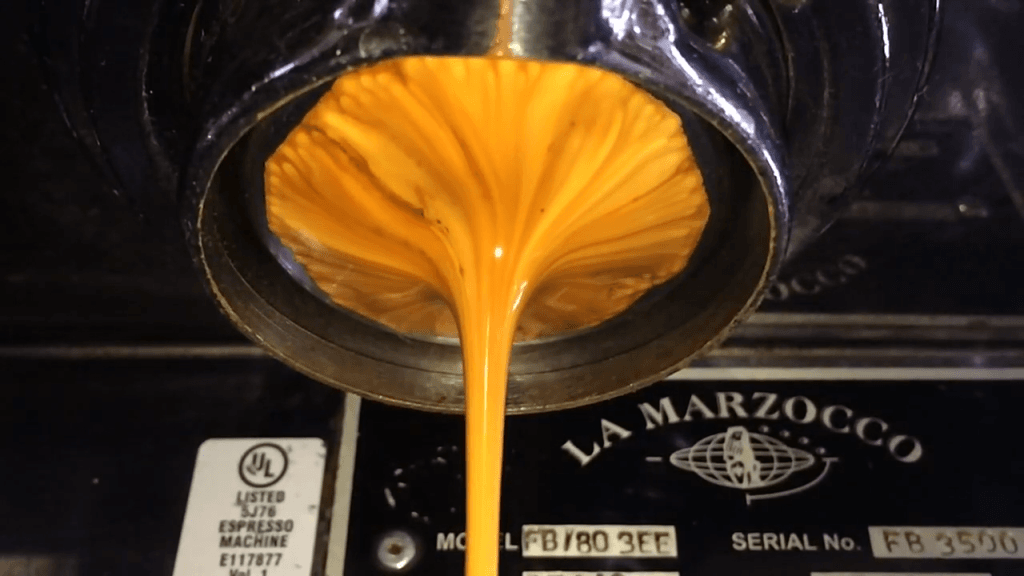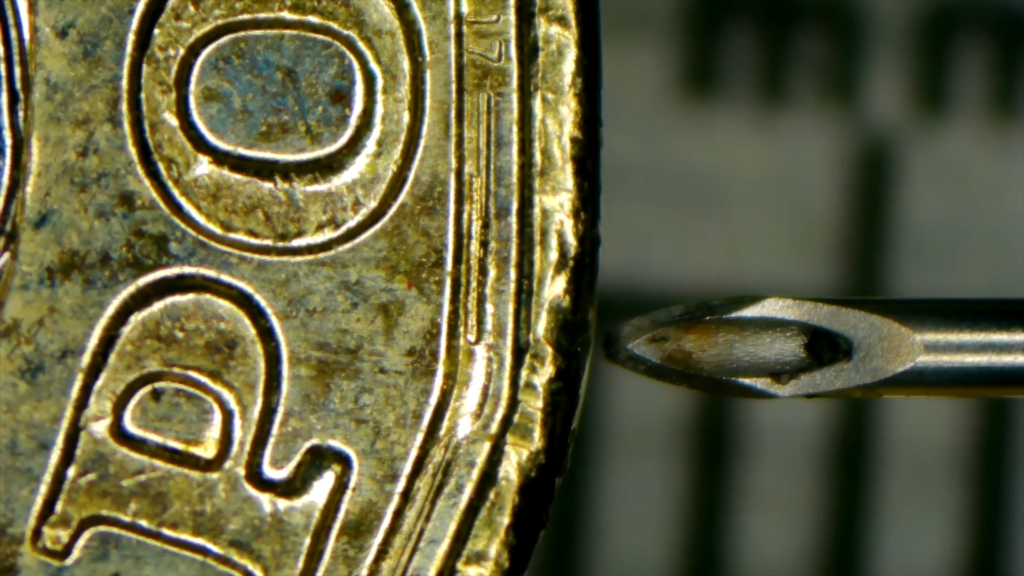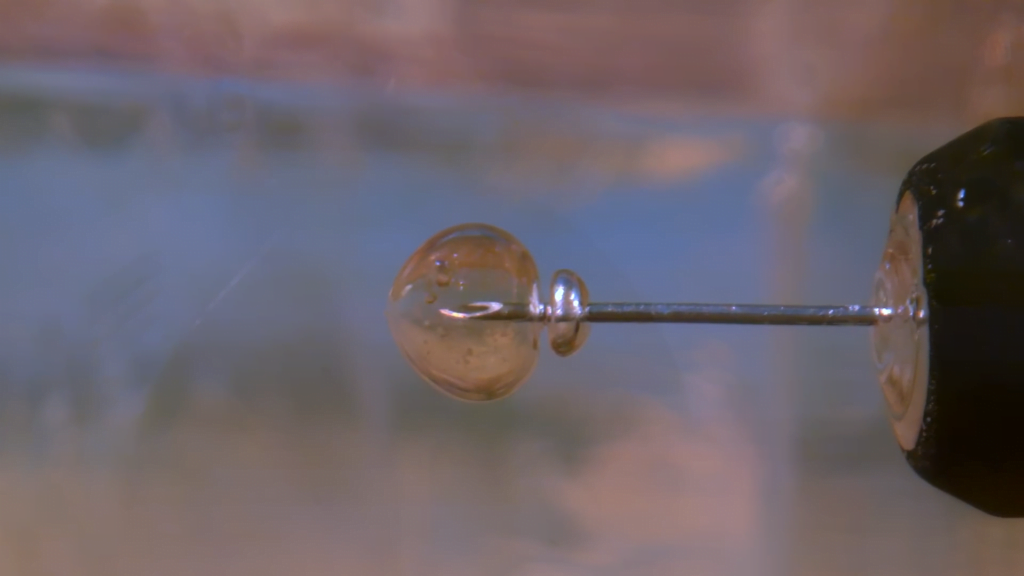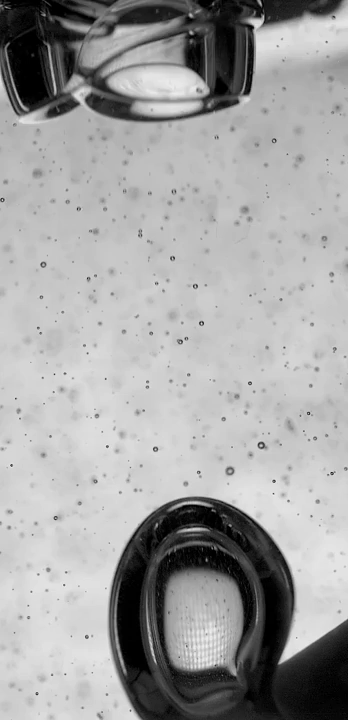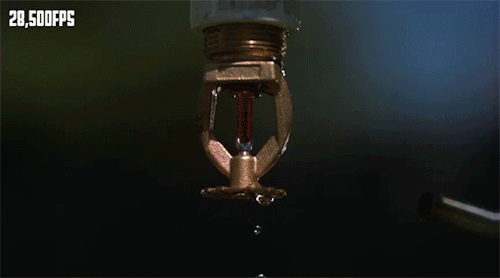Espresso has some pretty cool physics. But it’s also just lovely to watch in slow motion. This video offers a look at the making of an espresso shot at 120 frames per second (though you can also enjoy a 1000 fps version here). Watching the film form, expand, and break up at the beginning and end of the video is my favorite, but watching how the occasional solid coffee grains make their way into and down the central jet is really interesting also. (Video and image credit: YouTube/skunkay; via Open Culture)
Tag: high-speed video

EpiPen in Action
Researchers are hard at work developing needle-free alternatives to injection, but devices like the EpiPen — used in anaphylactic emergencies for food and insect allergies — aren’t going anywhere yet. In this Slow Mo Guys video, they show what happens when an EpiPen fires into ballistic gel.
An EpiPen’s needle is extremely narrow and about 15 millimeters long. It enters the gel (and presumably the human body) at a modest speed of ~6 m/s, releases the medication, and retracts. Despite its relatively slow speed, the needle is visibly blunted after use (and, no, the EpiPen is not reusable, for this and other reasons).
Injections like this may be tough for some people to see, but as Dan’s mother attests, they’re absolutely life-saving for the patients that need them. (Video and image credit: The Slow Mo Guys)

Aerated Faucets
So much goes on in our daily lives that we never see. But with the power of the smartphones in our pockets, we can catch more than ever before, as illustrated in this video. Here a researcher uses the standard “slo-mo” (240 fps) video mode on a smartphone to look at the flow from a typical kitchen faucet. Household faucets often have an aerator that adds air bubbles to the flow, something that’s particularly visible in slow motion at high flow rates. What you can see depends on more than just the frame rate, though. Without strong illumination — provided in this case by sunlight — you could easily miss the cloud of droplets ejected by the faucet. (Image and video credit: M. Mungal)

Really, Really Slow Mo Fluids
Fluid dynamics is a perfect subject for high-speed video. So much goes on at speeds that are far too quick for our eyes and brains to perceive. But there is such a thing as too slow – a concept explored in this Slow Mo Guys video, which takes everyday activities like turning on a faucet or splashing into a pool and slows them down a speed where one second lasts an hour. The video I’ve embedded here isn’t nearly that long; it speeds up and slows down. But if you really want to, you can watch Gav fall into a pool for a full hour. (Image and video credit: The Slow Mo Guys)

Bubbles Rising
Here we see high-speed video of air bubbles rising through sesame oil. The flow rate of air is just right for one bubble to catch up to and merge with the previous bubble. As it the trailing bubble pinches off from the valve, it shoots a small jet through itself and into the prior bubble. For information on how to recreate this and related experiments, check out this article. (Image credit: C. Kalelkar and S. Paul, source; see also C. Kalelkar)

“Dancing With Danger”
Filmmaker Chris Bryan captures surfer Kipp Caddy as he rides an enormous wave in “Dancing With Danger.” Nothing quite captures the majesty of these powerful flows like high-speed videography. Enjoy the break, the spray, and those awesome rib vortices. (Image and video credit: C. Bryan)

How Fire Sprinklers Work
Most of us have probably never given much thought to how a fire sprinkler works, but fortunately, the Slow Mo Guys have used their high-speed skills to answer that question anyway. Sprinkler systems of this variety are constantly pressurized by a full pipe line of water that’s held back by a thin metal disk and a colored glass ampule containing a fluid like alcohol. The color of ampule indicates the temperature at which the system is designed to activate. As the ampule heats up, the fluid inside expands, breaking the ampule at or near the critical temperature. That allows the metal disk to fall away and releases a torrent of water, which falls onto the gear-like disk at the bottom of the sprinkler and gets flung out over a wider area. Despite appearances, that bottom disk is stationary, not spinning; its shape alone is what distributes the water. (Image and video credit: The Slow Mo Guys)


Slow Mo Geyser
Geysers are one of the most surreal wonders of our planet – pools of turquoise that periodically erupt into towers of water and steam. But what we see from the surface is only a small part of the story. Geysers require two main ingredients: an intense geothermal heat source and the right plumbing. Below ground, that plumping needs both a reservoir for water to gather and narrow constrictions that encourage the build-up of pressure.
A cycle begins with water filling the reservoir; this can be both geothermally heated water and groundwater seeping in. As the geyser fills, the pressure at the bottom increases. Eventually, the water becomes superheated, meaning that it’s hotter than its boiling point at standard atmospheric pressure. That’s when the steam bubbles you see above rise to the surface. When they break through, it causes a sudden drop in the reservoir pressure. The superheated water there flashes into steam, causing the geyser to erupt. Check out the full video below for some awesome high-speed video of those eruptions, and, if you’re curious what the inside of an active geyser looks like check out Eric King’s video. (Image and video credit: The Slow Mo Guys; submitted by @eclecticca)

Massive Worthington Jet
The FloWave facility in Scotland is one of the coolest ocean simulators out there. Equipped with 168 individual wave makers and 28 submerged flow-drive units, it’s capable of recreating almost any ocean conditions imaginable. So naturally the Slow Mo Guys used it to create a giant spike wave.
Essentially, this is an oversized Worthington jet, the same as the ones you see after a droplet hits the surface. But with several thousand tonnes of crystalline clear water, the effect of that wave focusing is pretty spectacular. When you’re watching the high-speed footage, be sure to pay attention to the details, like the glassy surface of the collapsing jet, or the way holes open and expand as the splash curtain comes down around Dan’s head (above). Longtime readers will recognize many familiar features. (Image and video credit: The Slow Mo Guys)

Spinning Paint
Several years ago Fabian Oefner started spinning paint, and it’s been a perennial favorite online ever since. Here the Slow Mo Guys revisit their own paint-spinning antics by super-sizing their set-up. In some respects, it’s a little dissatisfying; as with their first time around, they don’t moderate the drill speed at all, so after the initial spin-up, the centrifugal acceleration is so strong that it just shreds the paint instead of showing off the interplay between the acceleration and surface tension’s efforts to keep the paint together.
In their largest experiment, though, the Slow Mo Guys get some interesting physics. Here there’s only a single slot for paint to exit, so the set-up doesn’t lose all its paint at once. The centrifugal acceleration flings the paint out in sheets that stretch into ligaments and then tear into droplets as they move further out. But there’s some more complicated phenomena, too. Notice the bubble-like shapes forming in the yellow paint on the lower right. These are known as bags, and they form because of the relative speed of the paint and the air it’s moving through. This is actually the same thing that happens to falling drops of rain! (Video and image credit: The Slow Mo Guys)



